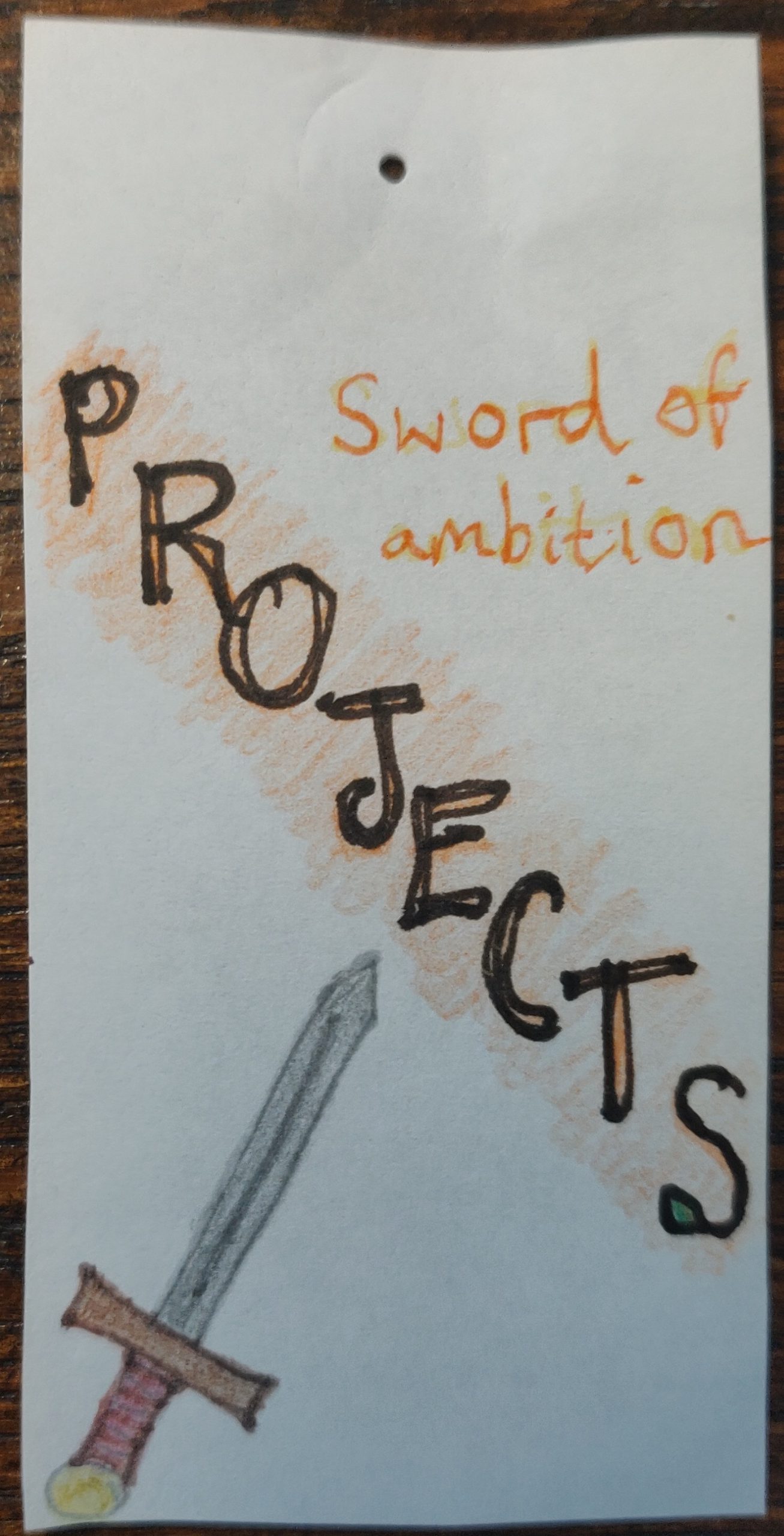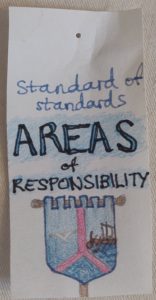
The Standard of Standards and the Sword of Ambition: thoughts on two types of goals (and how to set good ones)
Even at a job, work is not just one type of thing. This is even more true at home, where the work of life can vary wildly. So it can help to think about what we want to get done (our goals) in terms of two broad types (projects and areas of responsibility) as well as how we might set good goals.
Regulars
As soon as we started doing Home Scrum, we noticed that we needed to adjust how Scrum is normally done to fit. In the corporate world, most ‘tickets’ (tasks) are for unique coding jobs, so they move through the board once and then they’re done. In life, however, a lot of the work that needs doing is made up of repeating tasks (particularly for housework and health), so the concept of ‘regular’ tasks was born.
Nowadays, we keep our regulars in their own column, completely separate from the rest of the backlog of tasks. We also group the regulars by colour so it’s easier to find the one we’re looking for. If they repeat daily, they only ever rotate between the ‘Doing today’ and ‘Done’ columns; if they repeat on a set schedule, then we move them from ‘Done’ straight onto the next relevant day on the calendar. This works very well and was the first thing we noticed was working for us when we started using Scrum—suddenly we were missing a lot fewer bin days.
Different types of goal
Like finding that there is a difference between one-off tasks and regular tasks, we found that there are different types of goal—and I don’t just mean long-term, medium-term or short-term. At the broadest level, Francis and I organically came up with a decent system for recognising two main types of goal.
Francis had made a full-on adventure game to play based on the story points we earned each day. For that game, Francis invented lots of ‘items’, and two of these were the ‘Sword of Ambition’ and the ‘Standard of Standards’.

The goals that fit under the ‘Sword of Ambition’ were things which we might classically think of as goals: finite—things that we could one day actually finish. An alternative name for this type of goal would be ‘Projects.’ Although these are the goals that people are often talking about when they discuss goal-setting, I’ve found that projects are actually rarer than the other sort of goal—they’re more like the icing on the cake of life that you can reach for if you’ve got the mental space available.

The goals that fit under the ‘Standard of Standards’ almost always consisted of a change to our ‘Regulars’, because these goals involve an ongoing, long-term and potentially infinite adjustment to our daily habits and lifestyle. These are by far the harder form of goal, because there isn’t that epic push towards some kind of finish line. Instead it’s all about maintenance, which has very little glamour about it. Calling it the ‘Standard of Standards’ (like an actual battle standard, get it?) gave these goals an extra meaning, as if we were part of an epic quest, and the things we were trying to get done were all adding up to something. Any story that you want to spin out of your life and your to-do list can be reflected on your Home Scrum board if you want, and that can really help to nurture a sense of purpose beyond the daily grind.
Another name for ‘Standard of Standards’ goals is ‘Areas of Responsibility’ (which, like ‘Projects’ above, is a category from the PARA system). These areas can be described in the form of roles, such as ‘daughter’, ‘spouse’, ‘sibling’, ‘friend’, ‘pet-owner’, ‘house-owner’, ‘minimalist’, etc. I find it helpful in an abstract sense to have this framework within which to think about my goals, although if I actually go ahead and list out all of the possible areas of responsibility and projects I could be doing, I can quite reliably trigger a perfectionism spiral and a debilitating sense of overwhelm. (No-one can work on all of their different projects/areas at once!)
How to set good goals
Is this goal even something you need to be doing?
This question is huge—big enough for it to get its own blog post. But as a bit of a starter, to refine your goals and uncover your actual underlying purpose for doing them you can use the ‘9 Whys’ technique. Keep asking yourself “Why do we want to achieve that?” nine times, which should get you to the point where you can articulate your reasons more clearly. If those reasons aren’t actually very rational, consider whether you need to achieve this goal at all.
For instance, I have a goal to ‘decorate the whole house.’ But if I ask myself why I want to do this, I come up with things like ‘I want to feel more comfortable in my home space’ and ‘I want to feel proud of my home rather than self-conscious when people come over.’ When I examine these reasons in turn, I can see that some of them are less valid than others. However, ultimately I can see that designing my environment to support me in my desired lifestyle will be a very useful thing to do, and I feel more motivated and committed to the goal of decorating the house.
Ultimately, a lot of goals are just another activity. If you can connect it to the reason you want to do it, you will literally be giving more meaning to your life.
Will you know when your goal is done?
I said above that ‘Project’ goals are finite, that they can be finished. But how do you know when you’re finished? For instance, my goal to ‘decorate the whole house’ is not really sufficiently concrete. What constitutes ‘whole’? Every cupboard? The loft? The exterior?
To make sure that you can know without doubt when you are done, you need to make sure your goals are both specific and measurable. Perhaps for my house example, this could look something like: ‘My goal to decorate the house will be finished when all the rooms (including the hallway) have been rewired, replastered, painted, carpeted, and furnished, with permanent homes found for all of the objects in the house.’
Is your goal in your circle of control?
Another thing to consider about goals is whether or not they are something you can actually control. For instance, we often set a goal based on the outcome we want—e.g. wanting to get to a thousand subscribers on your YouTube channel. But that’s something that you can’t make happen, you can only indirectly influence it. Instead, you could make your goal something like ‘I will release one video a week,’ which will hopefully lead to the outcome you want, but even if not, you will still have succeeded in your goal.
Could your goal be converted into a habit?
Another thing to think about regarding goals is to think about whether you’ve set a ‘tall and narrow’ goal or a ‘wide and shallow’ goal. A ‘tall and narrow’ goal is in fact a project/sword of ambition type goal, i.e. something with a set, one-off end-date, like ‘pass my maths GCSE exam.’ This is a far-off, intimidating goal that probably won’t help to motivate you or to see how to get there. If instead you reframe this into a ‘wide and shallow’ goal (in fact an areas of responsibility/standard of standards type goal), such as ‘I will spend ten minutes every day this year on Khan Academy following their maths course’, this is a much more achievable and immediate goal that, if made small enough, is downright easy to do. Ten minutes is a tiny commitment, but doing something daily is actually very ambitious. So it shifts the ambition across a long timeframe (it’s ‘wide’) but keeps the actual action tangible and approachable (‘shallow’).
There’s lots more to say about how to set good goals, but there is also plenty of advice out there on the internet and in self-help books about it. Just remember to consider the underlying purpose of what you are trying to achieve, which a lot of self-help doesn’t spend time questioning.







